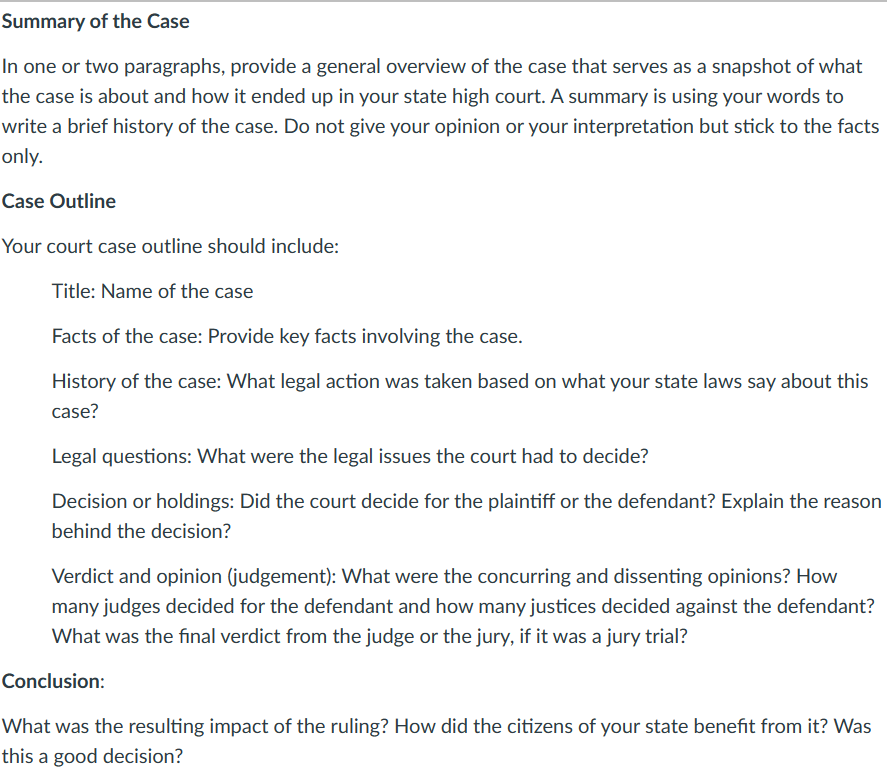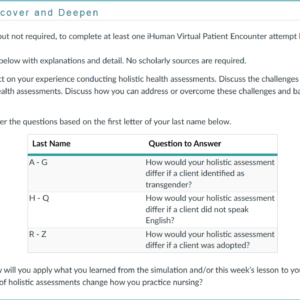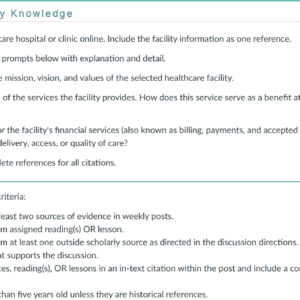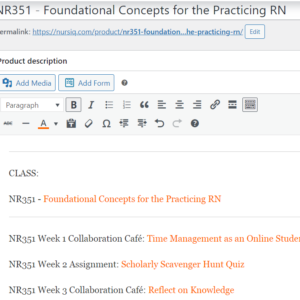ENTIRE CLASS WEEK 1 – 8:
POLI330N – Political Science
POLI330N Week 6: Part I How the Courts Address or Respect Our Rights as Citizens – Outline
Instructions
This assignment is comprised of 2 parts, the first of which is due this week. Part II will be due in Week 7.
In Part I this week, choose a Federal Supreme Court case that originated in your state that involves civil rights or civil liberties that was heard by the United States Supreme Court, and a decision was rendered. If your state does not have a case that was decided by the United States Supreme Court, choose a civil rights case from another state for which the United States Supreme Court issued a decision.
Here is a brief description of civil rights and civil liberties: Civil rights refers to equal social opportunities under the law. It gives you these freedoms, such as the right to vote, the right to public education, or a fair trial, among other things, regardless of your wealth or race. Civil liberties mean freedom of religion, equal treatment and due process under the law, and the right to privacy.
You should be able to go online and look up your state and famous cases decided by the Supreme Court. For example, Brown v Board of Education (1951) started in Topeka, Kansas, and ended up in the Supreme Court of the United States. Another example would be Calvary Chapel Dayton Valley v Steve Sisolak, Governor of Nevada (2020), which started in Nevada and ended up in the United States Supreme Court. A good source of information about cases decided by the United States Supreme Court is www.scotusblog.com, www.justia.com, or www.oyez.org.
Some other examples of cases include Lau v Nichols, Tinker v Des Moines Independent Community School District, Terry v Ohio, Regents of California v Bakke, Schenck v United States, Plessy v Ferguson, Shelley v Kraemer, Texas v Johnson, Ysleta del Sur Pueblo v Texas, Korematsu v United States, Obergefell v Hodges, Laird v Tatum and Loving v Virginia.
Other sources can be researched online using search terms for “civil rights cases decided by the U.S. Supreme Court.” Be sure to use a case actually decided by the United States Supreme Court, and not a case decided by your state’s supreme court or a different court. A case that is still pending before the United States Supreme Court should not be used. If you are unsure, please contact your Professor BEFORE you pick your case and submit the assignment as this is a significant part of your overall grade.
Research your court case and write an outline of the case that you will be using to prepare a presentation, which will either be a narrated PowerPoint, a Kaltura Video, or some other format as approved by your instructor. If you are unsure, then verify the presentation format with your instructor before starting work on this assignment.
This week’s assignment should include (a) summary of the case; (b) a case outline; and a summary.
Summary of the Case
In one or two paragraphs, provide a general overview of the case that serves as a snapshot of what the case is about and how it ended up in your state high court. A summary is using your words to write a brief history of the case. Do not give your opinion or your interpretation but stick to the facts only.
Case Outline
Your court case outline should include:
Title: Name of the case
Facts of the case: Provide key facts involving the case.
History of the case: What legal action was taken based on what your state laws say about this case?
Legal questions: What were the legal issues the court had to decide?
Decision or holdings: Did the court decide for the plaintiff or the defendant? Explain the reason behind the decision?
Verdict and opinion (judgement): What were the concurring and dissenting opinions? How many judges decided for the defendant and how many justices decided against the defendant? What was the final verdict from the judge or the jury, if it was a jury trial?
Conclusion:
What was the resulting impact of the ruling? How did the citizens of your state benefit from it? Was this a good decision?
SOLUTION
Part I: How the Courts Address or Respect Our Rights as Citizens – Outline
Case Summary
After the Civil War and the beginning of the Reconstruction Process, came the Civil Rights Act of 1875. This great law sought to deal with racial discrimination, mainly focused on the formal removal of African Americans from certain places. Nevertheless, racial discrimination remained rampant for many subsequent years of the corporate existence. On this front, one saw the lack of integration of African Americans in schools or other public places; or their dismissal right out of the workplace or denied basic services (Greenberg & Page, 2018). Therefore, high……………………….purchase entire solution at $10 only





Reviews
There are no reviews yet.